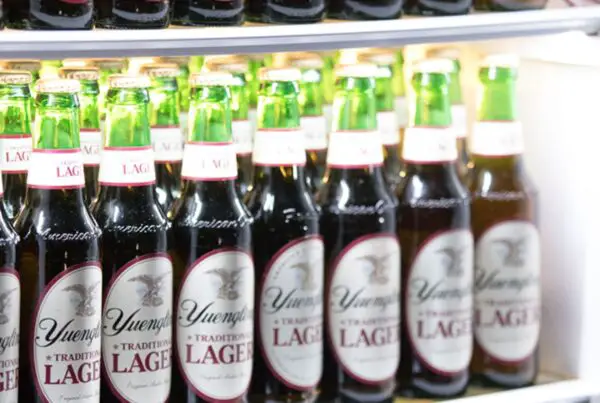What does ABV mean in beer, and how is it calculated?
Beer ABV is the beer’s alcohol by volume and couples with IBU is one of the two most common numbers referenced by beer drinkers. Alcohol by volume refers to the amount of alcohol in the beer. It’s calculated using a formula that includes the original and final gravity of the beer. The alcohol is a byproduct of yeast and comes from the fermentable sugars that the yeast eat during fermentation. Beer styles range in ABV from around 3% up to 13%. Continue reading to find out more about ABV in beer, how it’s calculated, and why it’s important.
What is ABV?
ABV stands for Alcohol by Volume. It’s the amount, shown as a percentage, of pure alcohol inside of a beer. In beer, ABV ranges from roughly 3-13% and sometimes beers have an ABV outside of that range. It is mathematically calculated using the original and final gravity of the beer. The alcohol (ethanol) content of beer is determined after fermentation; the process where yeast converts sugars into ethanol.
Where does the Alcohol in ABV come from?
Alcohol comes from the sugars used in beer. The sugar comes from a process called mashing where grains are mixed with water and the fermentable sugars separate. What’s left is called the wort; a sugary mixture that the yeast will eventually eat and turn into ethanol. The wort is boiled and cooled and transferred into a fermenter.
Fermentation is where the alcohol is created. Dry or liquid yeast is added to the fermenter with the transferred wort, where the yeast eats the sugars and produces ethanol. Ethanol is the alcohol in the finished beer, and is what’s measured in the ABV. The more sugars that the yeast eat during fermentation, the higher the resulting beer’s ABV will be.
How is beer ABV calculated?
ABV in beer is calculated with a simple formula. It’s determined by subtracting the beer’s final gravity from the original gravity and multiplying it by 131.25. The most basic formula for calculating ABV is as follows:
(𝑂𝐺 − 𝐹𝐺) ✕ 131.25
What is gravity in beer?
The gravity of the beer is essential to the understanding of ABV. Gravity is the measurement of fermentable sugars present in the beer before and after brewing. Original gravity is the number of sugars present before fermentation. Final gravity is calculated using a hydrometer and tells brewers how much of the sugar from the wort or other fermentable ingredients (beers brewed with fruits introduce more fermentable sugars) turned into alcohol during fermentation.
How Accurate is ABV in Beer?
Assuming the original and final gravity of the beer (the number of fermentable sugars in the beer at the beginning and end of brewing) are measured accurately, then the ABV is close to 100% accurate, barring a few decimal points.
Beer ABV based on style
Some beer styles have higher ABVs than others. For example, light lagers have lower ABVs than Barleywines. The ABV of a beer plays a critical role in determining the style of the beer. A pilsner will never exceed 5.5% ABV, and an Imperial Stout will never have an ABV below 7%.
Here are some ABV ranges of 10 popular beer styles, listed from low to high:
1. American Light Lager (4.1-5.1%)
2. Blonde Ale (4.1-5.1%)
3. German-style Pilsner (4.6-5.3%)
4. Kolsch (4.8-5.3%)
5. American-style Pale Ale (4.4-5.4%)
6. Amber-style Lager (4.8-5.4%)
7. Brown Ale (4.2-6.3%)
8. American-style Stout (5.7%-8.0%)
9. American-style India Pale Ale (6.3%-7.5%)
10. Barley Wine (8.5%-12.2%)
Why Is ABV Important?
Knowing the ABV of a particular beer helps beer drinkers understand just how potent the alcohol will be. The wide range in ABV is why having a few Bud Lights will not make you as tipsy as even just one IPA can. This helps people enjoying a day or drinking better judge their tolerance and actual volume of alcohol consumed allowing them to hopefully make better informed decisions.






